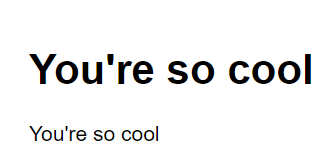Express - Mini Project - Library (part 1 skeleton)
1 SETUP
:: npm install express-generator -g
@echo off
set /p projectName="Enter project name: "
express %projectName% --view=pug
:: Change DIR
cd %projectName%
:: Install Dependency
npm install
:: Run app (bash/Linux)
DEBUG=%projectName%:* npm start
:: Load Browser
http://localhost:3000/QuickStart.bat
@echo off
:: DEBUG with Current Folder
for %%I in (.) do set CurrDirName=%%~nxI
echo %CurrDirName%
SET DEBUG=%CurrDirName%:* & npm start
:: After nodemon use
:: npm run devstart
pause2 Enable Restart on File Change
npm install --save-dev nodemon
:: Check installed dependency "devDependencies": {
"nodemon": "^2.0.4"
}3 Folder Structure Defined
express-locallibrary-tutorial
# Creates Express App. Object
# Set up view(template) engine
app.js
# Application Entry Point
/bin
www
# Application Dep. Info
package.json
package-lock.json
# Module Storage
/node_modules
[about 6700 subdirectories and files]
# Handles Static Files
/public
/images
/javascripts
/stylesheets
style.css
# Uses router model to define callback when the matching HTTP GET request pattern is detected
/routes
index.js
users.js
# For Storing responses to render with
/views
error.pug
index.pug
layout.pug
4 Send test message to routed template
users.js
router.get('/cool', function(req, res, next) {
res.render('challenge1', { title: 'You\'re so cool' });
});challenge1.pug
extends layout
block content
h1= title
p #{title}Result

5 Install DB
npm install mongooseAdd connection to app.js after var app = express();
//Set up mongoose connection
var mongoose = require('mongoose');
var mongoDB = 'insert_your_database_url_here';
mongoose.connect(mongoDB, { useNewUrlParser: true , useUnifiedTopology: true});
var db = mongoose.connection;
db.on('error', console.error.bind(console, 'MongoDB connection error:'));6 Setup in Mongo DB Atlas
https://www.mongodb.com/cloud/atlas
7 Add Models
author.js
var mongoose = require('mongoose');
var Schema = mongoose.Schema;
var AuthorSchema = new Schema(
{
first_name: {type: String, required: true, maxLength: 100},
family_name: {type: String, required: true, maxLength: 100},
date_of_birth: {type: Date},
date_of_death: {type: Date},
}
);
// Virtual for author's full name
// Virtual properties are properties that can be used by the template for getting and setting.
AuthorSchema
.virtual('name')
.get(function () {
return this.family_name + ', ' + this.first_name;
});
// Virtual for author's lifespan
AuthorSchema.virtual('lifespan').get(function() {
var lifetime_string = '';
if (this.date_of_birth) {
lifetime_string = DateTime.fromJSDate(this.date_of_birth).toLocaleString(DateTime.DATE_MED);
}
lifetime_string += ' - ';
if (this.date_of_death) {
lifetime_string += DateTime.fromJSDate(this.date_of_death).toLocaleString(DateTime.DATE_MED)
}
return lifetime_string;
});
// Virtual for author's URL
AuthorSchema
.virtual('url')
.get(function () {
return '/catalog/author/' + this._id;
});
//Export model
module.exports = mongoose.model('Author', AuthorSchema);REF
https://developer.mozilla.org/en-US/docs/Learn/Server-side/Express_Nodejs
